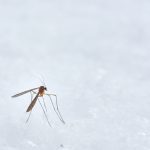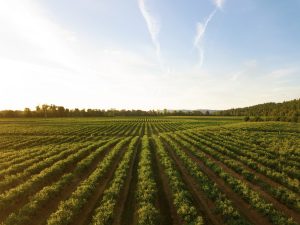Ua makemake kahi mea iÄ Ê»oe e hauÊ»oli Ê»O ka Ê» Moshane ma ke ao?
AÊ»ole nÅ wai. Ê»Oiai ka manawa. I kÄ“lÄ me kÄ“ia makahiki, hÅÊ»ailona mÄkou i ke ao Ê»ana o ka MÅ«hou i ke Ê»Aukake 20. HoÊ»onohonoho Ê»ia ma 1897, ke kumu e hÄpai ai i ka Ê»ike e pili ana i ka pilina o nÄ Ê»ikepili a me ka maÊ»i maÊ»i i Ê»ike mua Ê»ia e ka mea noiÊ»i Pelekane Ê»o Sir Ronald Ross ma ka Liverpool School of Tropical Medicine..
 Ê»O ka acronym no ka lÄ hiki iÄ WMD, except that it’s already taken by “mea kaua o ka luku luku Ê»ana.” AkÄ he ala kÅ«pono kÄ“ia e noÊ»onoÊ»o ai i nÄ namu. Ê»O kÄ“ia mau Ê»Åla-kao koko he maÊ»i nÅ e hoÊ»oulu Ê»ia ana nÄ WMD. Ua kapa iÄ lÄkou i nÄ Center no ka maÊ»i maÊ»i a me ka pale “the world’s deadliest animal.”
Ê»O ka acronym no ka lÄ hiki iÄ WMD, except that it’s already taken by “mea kaua o ka luku luku Ê»ana.” AkÄ he ala kÅ«pono kÄ“ia e noÊ»onoÊ»o ai i nÄ namu. Ê»O kÄ“ia mau Ê»Åla-kao koko he maÊ»i nÅ e hoÊ»oulu Ê»ia ana nÄ WMD. Ua kapa iÄ lÄkou i nÄ Center no ka maÊ»i maÊ»i a me ka pale “the world’s deadliest animal.”
He lÄÊ»au Ê»eha kahiko lÄkou, aka, hiki i ka Ê»epekema 21st i hiki ke kÅkua iÄ mÄkou e lanakila i kÄ lÄkou hoÊ»oweliweli, using tools similar to the ones we’ve developed to grow the best and healthiest crops the world has ever seen.
Ê»AÊ»ole wau i aloha i nÄ namu akÄ aloha lÄkou iaÊ»u. I’m a laka i ka makika—kekahi hapa o na mea piÊ»o 20 ka pakeneka o ka heluna o nÄ kÄnaka noiÊ»i o ke Kulanui o Florida e Ê»Äpono mau loa. A Ê»Ä lÄkou iaÊ»u, UÅ aÊ»e au me nÄ welts.
As much as I’d like to say that we should wipe out the global population of mosquitoes, that isn’t really the goal. Ê»AÊ»ole wale nÅ o ka 3,500 Ê»ano like Ê»ole o ka huaka i ke kanaka. Ke waiho nei ke koena iÄ mÄkou wale nÅ a hÄÊ»awi i nÄ meaÊ»ai no nÄ manu, popo, baki, a me nÄ mea ola e ae. They’re even pollinators that help plants reproduce.
Ê»O ka mea e Ê»Äʻū iÄ mÄkou, nae, hiki ke hoÊ»okuÊ»u i nÄ maÊ»i make. Malaria manawa make i nÄ haneli he mau tausani o nÄ makahiki i kÄ“lÄ me kÄ“ia makahiki, aemaise aku hoÊ»i i ka honua kÅ«kulu. Other mosquito-borne diseases are a rogue’s gallery of horrible ailments: Ê»ala nÄwa, maÊ»i maÊ»i maÊ»i, nÄ Ê»ano like Ê»ole encephalitis, a oi.
There’s also the Zika virus, ua pÄlahalaha aku nei ma nÄ wahi a puni. Ua hoÊ»opili Ê»ia nÄ kÄnaka noiÊ»i i nÄ hemahema o ka hÄnau Ê»ana, me ka mea weliweli i kapa Ê»ia Ê»o microcephaly, ka mea e hoÊ»opiÊ»i ma nÄ pÄ“pÄ“ me nÄ puÊ»uwai liÊ»iliÊ»i. (Ê»EhÄ mau makahiki i hala aku nei, Ua kÄkau wau e pili ana i ka weliweli o Zika iiiai a iiiai.)
ʻO ka haʻahaʻa o ka ʻūlū ke kuleana no ka nui o ka ʻeha o ke kanaka.
 Hiki iÄ mÄkou Äpau ke hana i nÄ hana maÊ»alahi e mÄlama i nÄ namu kokoke i ko mÄkou mau home ma ke kÄpae Ê»ana i nÄ kahua kanu. HoÊ»okomo Ê»ia ka papa hana me ka uhi Ê»ana i nÄ hÄmeÊ»a hÄmama a wehe Ê»ole i nÄ kukuna e Ê»ohi ana i ka wai. Ê»O ka waiho Ê»ana i kÄ“lÄ frisbee kÅ«waho i loko o kou pÄkeke e hiki ke hana i ka Ê»okoÊ»a.
Hiki iÄ mÄkou Äpau ke hana i nÄ hana maÊ»alahi e mÄlama i nÄ namu kokoke i ko mÄkou mau home ma ke kÄpae Ê»ana i nÄ kahua kanu. HoÊ»okomo Ê»ia ka papa hana me ka uhi Ê»ana i nÄ hÄmeÊ»a hÄmama a wehe Ê»ole i nÄ kukuna e Ê»ohi ana i ka wai. Ê»O ka waiho Ê»ana i kÄ“lÄ frisbee kÅ«waho i loko o kou pÄkeke e hiki ke hana i ka Ê»okoÊ»a.
Pono mÄkou e hoÊ»ohana i ka mana o ka Ê»epekema, oi aku.
 I nÄ mahinaÊ»ai, we’ve learned how to defend our crops from pests through traditional crop-protection tools as well as the innovation of GM crop technology. Ma muli o kÄ“ia kÅ«mamaÊ»a, we’re growing more food than ever before and feeding a planet of aneane 8 biliona kÄnaka.
I nÄ mahinaÊ»ai, we’ve learned how to defend our crops from pests through traditional crop-protection tools as well as the innovation of GM crop technology. Ma muli o kÄ“ia kÅ«mamaÊ»a, we’re growing more food than ever before and feeding a planet of aneane 8 biliona kÄnaka.
Now we’re applying this know-how to the problem of mosquito control. E komo pÅ« kaÊ»u moÊ»opuna i ka noiÊ»i. Ua aÊ»o Ê»o ia i ke ala o nÄ hua meka. If we’re going to eradicate some of the world’s worst infectious diseases, pono mÄkou e hoÊ»omaopopo a hoÊ»omaopopo i nÄ namu i kÄ“lÄ me kÄ“ia manawa i ko lÄkou ola. Hiki i kÄ“ia me ka hoÊ»omohala Ê»ana o nÄ kinipiko i palekana no ka poÊ»e akÄ akÄ i hÅÊ»ino i nÄ Ê»uÊ»uku.
Hiki i ka Ê»epekema hou o ka hoÊ»oponopono gen-hoÊ»oponopono i nÄ hopena hoÊ»omohala. One of the most intriguing involves the release of GMO male mosquitoes that mate with females but whose offspring don’t survive. Ê»O kahi mea i hala ma mua o kÄ“ia ala hele a hiki i ke kauÄ Ê»ana i kahi parasite i hoÊ»opakele i ka Ê»oihana holoholona. Ê»O ka entomologist hope Ê»O Edward F. Lace, nona wau i hanohano o ka ike ma o ka lawelawe ana ma na panaku USDA, hana i ka hoÊ»omanoke Ê»ana i ka hana hoÊ»oliÊ»i nui i ka pilikia o nÄ haki.
I ka wÄ i waho o Covid-19, we’re devoting enormous efforts to defeating an airborne disease that is responsible, ma keia palapala, no kahi kokoke 800,000 make honua. (NÄu laka don’t transmit ka coronavirus.) KÅ«pono loa kÄ“ia—a he kamaaina kamaaina, I’m trying to protect myself and others by living a life in near lockdown.
Ê»O nÄ nÅ«maka kekahi e hÅÊ»ike i kahi Ê»ano maÊ»i palu mau loa. Ê»O ke Ê»Ålima a me nÄ hoÊ»ololi Ê»ana i ke aniani e pono iÄ lÄkou pau loa, InÄ hiki Ê»ole iÄ mÄkou e hana.
The good news is that we’ll conquer the coronavirus. HÅÊ»ike nÄ hÅÊ»ike i nÄ nÅ«hou e loaÊ»a i nÄ pÄ«pÄ« i kahi kokoke e hiki mai ana.
.Ke neÊ»e nei mÄkou i mua i ka pilikia o Covid-19, let’s remember the menace of mosquitoes—a hana i ka hoÊ»omohala Ê»epekema a me nÄ kumuwaiwai pono e hiki ai iÄ mÄkou ke nÄnÄ i ka hiki Ê»ana o kahi honua me keÊ»ole o WMD.
E kaomi i 'aneÊ»i e hana i kahi hÄÊ»awi i ka Global Farmer Network.


